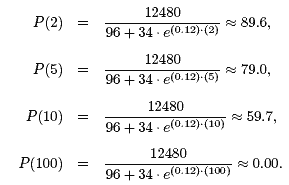Problem F-Predict how a population will change over time
Tutorial to help you solve this problem
P(t) is the population size
at time t (measured in days)
P0 is the initial population size
K is the carrying capacity of the environment
r is a constant representing population growth or decay
Suppose P0 = 96, K = 130, and r = - 0.12. Compute the population size when t = 2, t = 5, t = 10, and t = 100 days. What do you suggest happens to the population size as t → ∞ ? Use the logistic equation above to find your answer.
Tutorial

Computing the population size at the specified times,

We conclude that the population size decreases to extinction as t → ∞. This behavior occurs because r is negative (the death rate is greater than the birth rate).